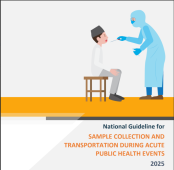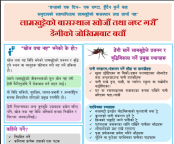Diarrhoea
Sign and Symptoms: Loose rice watery stool 15-20 episodes associated with nausea, vomiting & abdominal pain.
Affected area: Parshuram Municipality- 8 (Gairi gaun, Sano khola & Gupte gada, 3 villages)
Approximately 70 houses in those 3 villages
Onset: 29 Shrawan 2076 (14 August 2019)
- Total 81 cases of diarrhea were treated till date (1 referred to Seti Zonal Hospital and currently the case is stable condition)
- Cases were treated at Jamurani birthing center and Jogbuda Hospital since the onset
- Health team from Health Office, Provincial Health Directorate along with the required logistics were mobilized to the affected area on 30 Shrawan 2076
- Local RRT also mobilized
- Cases are in decreasing trend (Today only 4 new cases out of which currently, one admitted and is under IV)
- Out of 2 stool samples collected one is vibrio cholera positive from Dadeldhura Hospital, Dadeldhura
- The positive sample is planned to be brought to NPHL, Teku for re confirmation

Sep 18
National Guideline for SAMPLE COLLECTION AND TRANSPORTATION DURING ACUTE PUBLIC HEALTH EVENTS 2025
Read More
Jul 21

Jul 21
SEARCH AND DESTORY MOSQUITO HABITATS LEAFLET
Read More